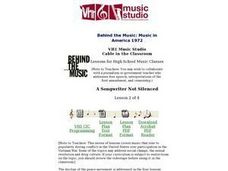Annenberg Foundation
Egalitarian America
What does a true American represent? Scholars investigate the equal rights era of the 1960s and 1970s in the 20th installment of a 22-part series on American history. Using photographic, magazine, written, and video evidence, groups...
National Endowment for the Humanities
"Sí, se puede!": Chávez, Huerta, and the UFW
"Sí, se puede!" Cesar Chavez and Dolores Huerta believed organizing farm workers and changing their working conditions were possible. Scholars examine provisions of the Bracero Program, videos, and the United Farm Workers' (UFW) work....
National Endowment for the Humanities
Revolution '67, Lesson 2: What Happened in July 1967? How Do We Know?
Even in a world in which dozens of participants and curious onlookers record every controversial event, the basic facts of what happened are often in dispute. Revolution '67, Lesson 2 explores 1967 Newark, New Jersey using an examination...
Constitutional Rights Foundation
Rachel Carson and the Modern Environmental Movement
Scholars analyze the environmental movement started in the 1960s. Through excerpts from Rachel Carson's books as well as diary entries, they take a look at the reason for the modern movement to save the planet and then create final...
Annenberg Foundation
America's History in the Making: Classroom Applications Four
The final installment of a 22-part American history series examines the many faces that make up the country's story. From Henry Ford to Tulio Serrano, scholars use biographical evidence and Internet research to uncover the people behind...
Anti-Defamation League
Shirley Chisholm: Unbought, Unbossed and Unforgotten
A 13-page packet introduces high schoolers to a lady of amazing firsts. Shirley Chisholm was the first Black woman elected to Congress, the first Black woman to run for President of the United States, and a leader of the Women's Rights...
National Endowment for the Humanities
Revolution '67, Lesson 1: Protest: Why and How
To some people, protesting is as American as apple pie, but the factors that lead to protests can be as confusing to veteran activists as to today's youth. Revolution '67 explores the riots in Newark, New Jersey as a case study. ...
Curated OER
A Songwriter Not Silenced - Lesson 2
Students discuss how a musician's message can influence society and government. They debate if political viewpoints should be publicized in music.
Curated OER
Artistic Influence - Lesson 3
Students discuss how musicians' messages can influence society. They think of examples of artistic expression in music, the visual arts, dance, and theater that can lead to a society's self-examination.
National Woman's History Museum
The Equal Rights Amendment
The debate over the Equal Rights Amendment continues. To better understand the controversy, class members research the history of attempts to get the amendment ratified. In addition, pairs engage in a structured academic conversation...
Curated OER
Moog's Musical Revolution
Students explore history of technological advances in making, recording, and listening to music that have intrigued and inspired musicians and scientists for decades.
Curated OER
New Voices for African Americans
Eleventh graders study Malcolm X and black power. In this African American lesson, 11th graders write a journal entry about black power and create a timeline of the events during the civil right movement.
University of California
The End of the Cold War (1979-1991)
Scholars use primary and secondary documents, as well as video evidence, to investigate the end of the Cold War. After completing the final installment of an eight-part series, class members better understand the issues surrounding...
VH1
Lessons for Hight School Music Classes: Lesson 2
Art and music have been vehicles for statements of civil unrest for hundreds of years. Upper graders critically analyze several pop songs or music movements from the 1980s that exemplify politically charged motives. They...
VH1
Lessons for Hight School Music Classes: Lesson 1
The phrase, "You sold out" has been thrown around among musicians that have lent their talents to the corporate world. Here, the class engages in an interesting discussion on how musicians make a living and the influence of commercialism...
Defining US
Integration of Education and American Society
How did the struggle for Civil Rights during the 1950s transform American society and politics? Why are American schools integrated today? Class members explore these essential questions by examining a series of primary and secondary...
Brookly Museum
Andy Warhol: The Last Decade
Discuss pop-art, Andy Warhol, and the concept of collaborative painting with your class. Learners won't be analyzing Warhol's work, but they will be engaging in group activities to understand the collaboration in art. They'll make a...
Curated OER
It is Our Right-Don't Waste It!
Students explore the basic rights granted to all American citizens by the U.S. Constitution in the light of women's issues. The women's suffrage movement, the role of Susan B. Anthony, and the timeline of events on voting rights are...
Curated OER
The "Me" Decade: 1970
High schoolers view the video on Mary Tyler Moore Show. They discuss what they notice about the treatment of Mary Tyler Moore's character in the show. Students listen to a lecture covering notes on web diagram, such as: Fads, fashion,...
Curated OER
Vocational: Fashion History
Students research and present reports on 20th century fashions and their influences. After watching a video about fashion, they complete worksheets based on the film. In another activity, students make doll-sized clothing items using...



















